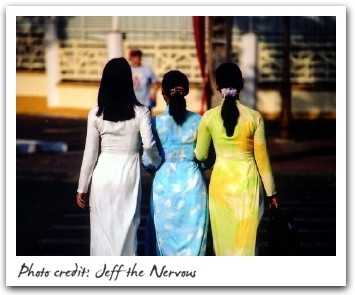

Daily Life :: Traditional Clothes
 A lasting impression for any visitor to Vietnam is the beauty of the women dressed in their long gowns called ao dais. It is a body-hugging, sweeping tunic with long sleeves worn over loose, flowing trousers that brush the floor. The tunic has a high neckline and side slits from the waist to the hem.
A lasting impression for any visitor to Vietnam is the beauty of the women dressed in their long gowns called ao dais. It is a body-hugging, sweeping tunic with long sleeves worn over loose, flowing trousers that brush the floor. The tunic has a high neckline and side slits from the waist to the hem.Colors often indicate the wearer's status ...
- young girls wear ao dais in pure white;
- young unmarried women wear delicate pastels; and
- married women in brightly-coloured tunic over white/black trousers.
Men once wear a variation of the ao dai with shorter and fuller tunic. Today, men generally wear it for traditional dance or music performance during ceremonial occasions.